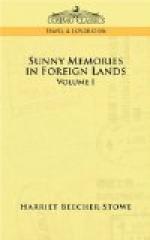But, in fine, at the end of all this we went back to our hotel to dinner. After dinner we set out to see the church. Even Walter Scott has not a more poetic monument than this church, standing as it does amid old, embowering trees, on the beautiful banks of the Avon. A soft, still rain was falling on the leaves of the linden trees, as we walked up the avenue to the church. Even rainy though it was, I noticed that many little birds would occasionally break out into song. In the event of such a phenomenon as a bright day, I think there must be quite a jubilee of birds here, even as he sung who lies below:—
“The ousel-cock, so black of hue,
With orange-tawny bill,
The throstle with his note so true,
The wren with little quill;
The finch, the sparrow, and the lark,
The plain-song cuckoo gray.”
The church has been carefully restored inside, so that it is now in excellent preservation, and Shakspeare lies buried under a broad, flat stone in the chancel. I had full often read, and knew by heart, the inscription on this stone; but somehow, when I came and stood over it, and read it, it affected me as if there were an emanation from the grave beneath. I have often wondered at that inscription, that a mind so sensitive, that had thought so much, and expressed thought with such startling power on all the mysteries of death, the grave, and the future world, should have found nothing else to inscribe on his own grave but this:—
Good Friend for Iesus SAKE forbare
To digg T-E Dust EncloAsed HERe
Blese be T-E Man T spares T-Es Stones
Y
And curst be He T moves my Bones
Y
It seems that the inscription has not been without its use, in averting what the sensitive poet most dreaded; for it is recorded in one of the books sold here, that some years ago, in digging a neighboring grave, a careless sexton broke into the side of Shakspeare’s tomb, and looking in saw his bones, and could easily have carried away the skull had he not been deterred by the imprecation.
There is a monument in the side of the wall, which has a bust of Shakspeare upon it, said to be the most authentic likeness, and supposed to have been taken by a cast from his face after death. This statement was made to us by the guide who showed it, and he stated that Chantrey had come to that conclusion by a minute examination of the face. He took us into a room, where was an exact plaster cast of the bust, on which he pointed out various little minutiae on which this idea was founded. The two sides of the face are not alike; there is a falling in and depression of the muscles on one side which does not exist on the other, such as probably would never have occurred in a fancy bust, where the effort always is to render the two sides of the face as much alike as possible. There is more fulness about the lower part of the face than is consistent with the theory of an idealized bust, but is perfectly consistent with the probabilities of the time of life at which he died, and perhaps with the effects of the disease of which he died.




